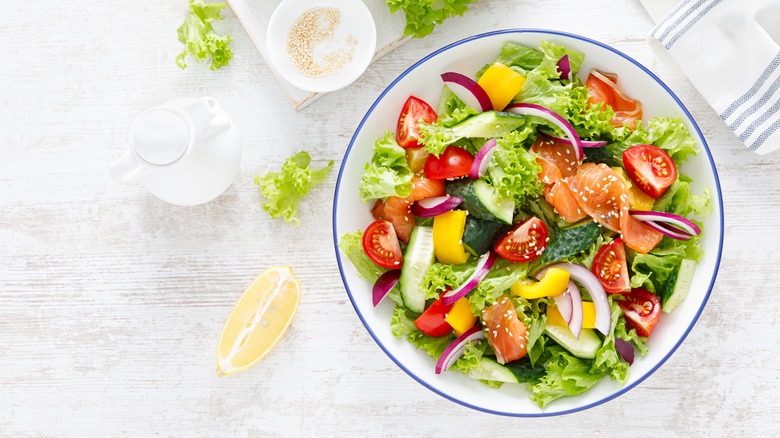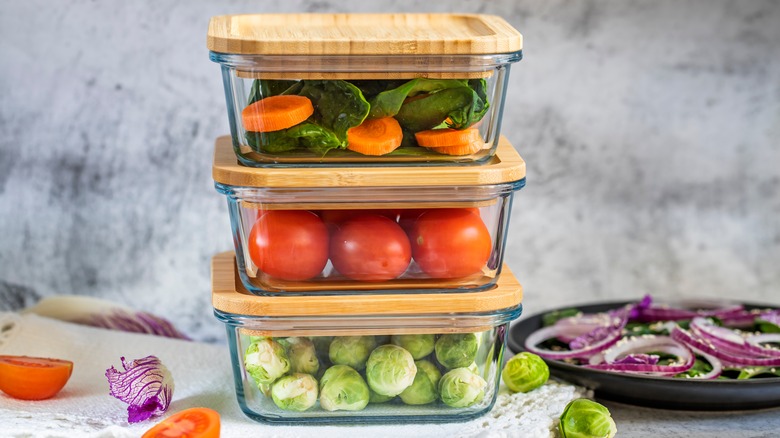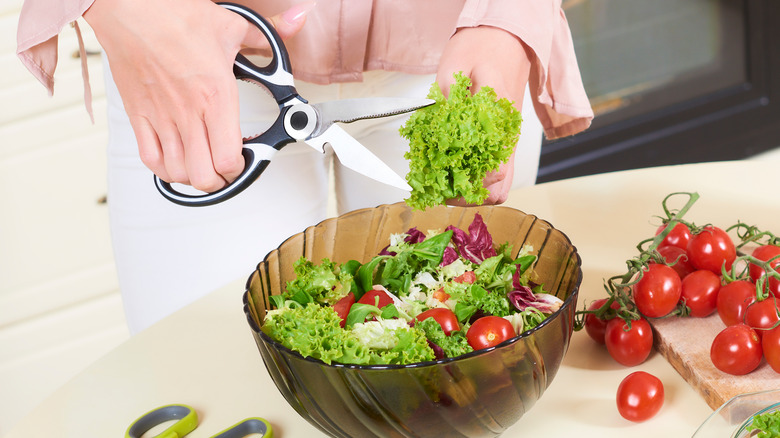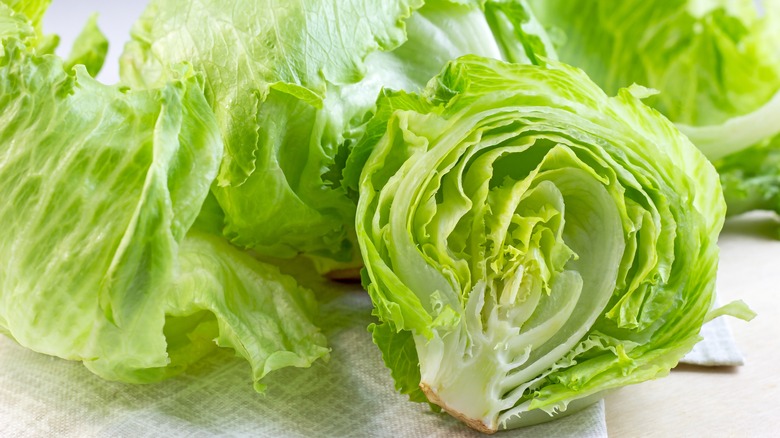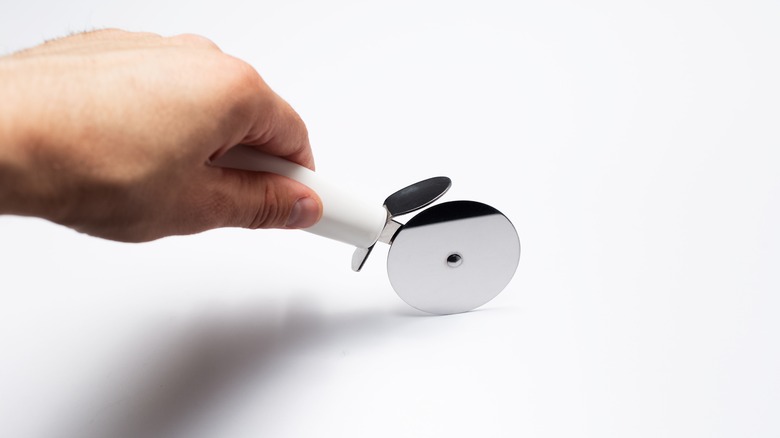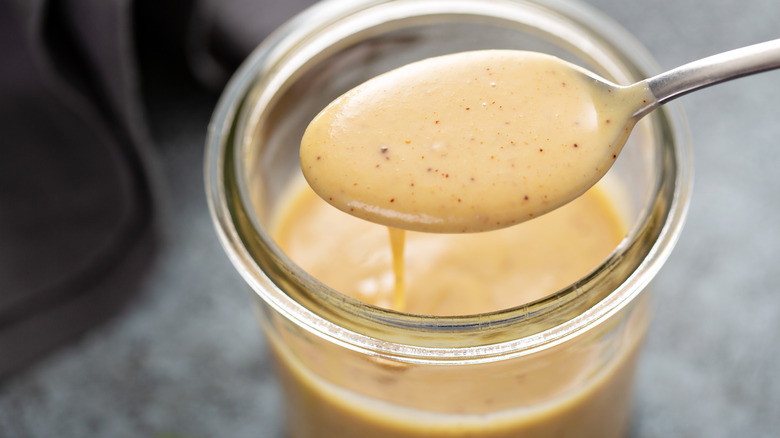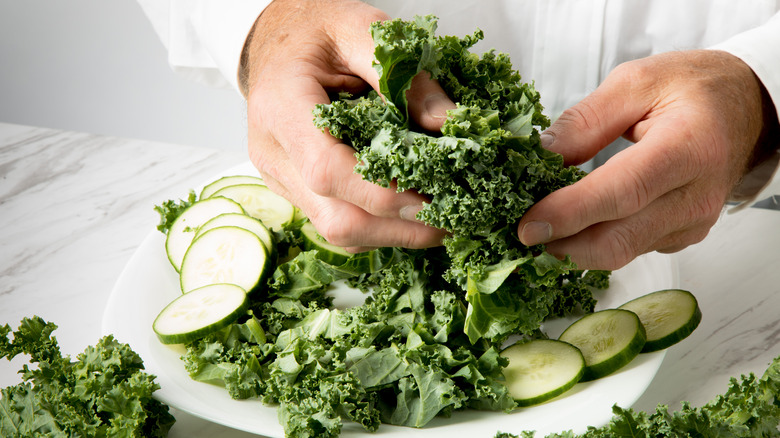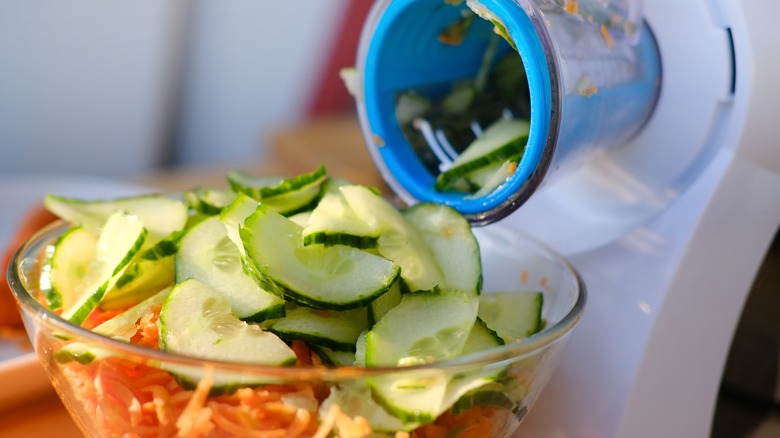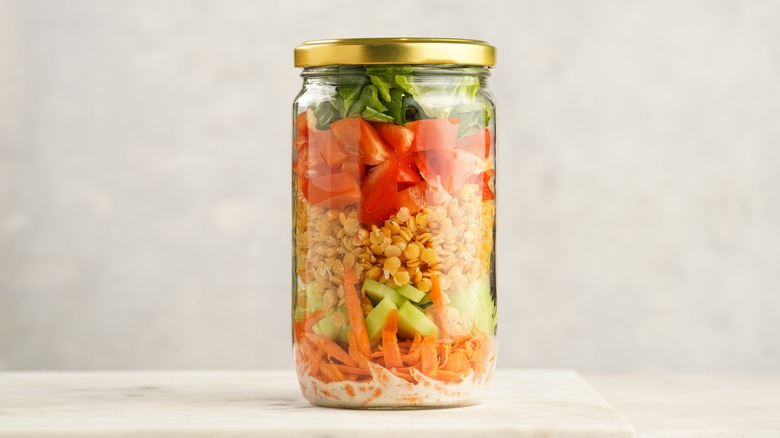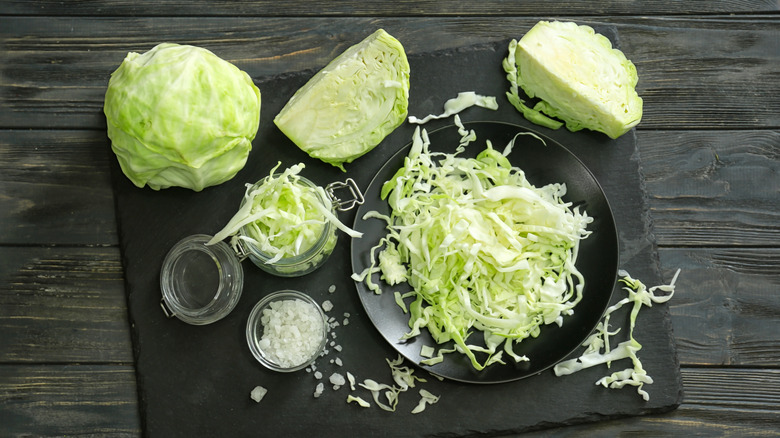13 Salad Making Hacks To Add To Your Repertoire
Keep your spring, your fall, and your winter. Our favorite season is salad season. And while you might be living your best salad life during the summer, in our opinion, they're a year-round option. Salad is a popular choice in many different countries around the world, and from the Italian Caprese to Thai som tam, there's something for everyone. Whether it's hot or cold out, for lunch or dinner, the bright, crunchy, zesty flavors of a well-made salad can't be beaten.
But no matter what style of salad you're making, there's a right and a wrong way to do it. And these thrown-together meals have an awful knack for being disappointing. With fresh ingredients that are highly prone to wilting and becoming watery, to dressings that lack significant punch or flavor, it's easy to mess these humble dishes up. But not anymore! With this collection of easy-to-master hacks, you'll not only be making great salads every time, but you'll be saving time, money, and effort while producing restaurant-quality meals. Let's take a peek at some of our favorite salad-making hacks.
Learn to meal prep your salads
So you've got a busy week coming up, and the idea of making meals every day is already causing you anxiety. In between all those meetings, gym classes, and commutes, there's not a lot of time to throw together food, meaning that you're facing the reality of spending a truckload of money on takeout lunches.
Instead of doing this, hack the system by learning to meal prep your salads. At the start of the week, spend a little bit of time in the kitchen chopping the vegetables you'd like to use in your salads. Then, prepare any grains or protein that you're also using, and allow anything you've cooked to cool completely. While you can then combine these into separate lunch boxes, we prefer to keep them in separate containers in your fridge, to stop things from getting too soggy.
Finally, whip together a big batch of dressing, enough to last you for the full week. Once everything is chopped and prepped, you're good to go. All you have to do each night is spend a minute or two grabbing what you want from each container, putting it in a lunch box, and adding your dressing (or preparing a mini-bottle of it to take with you, so it doesn't get too soggy). Trust us, it's a small amount of work for a large reward throughout the working week.
Grab some salad scissors to prep Insta-worthy salads
Greens are an integral part of many salads, and how you treat them makes all the difference to the result. Many greens can be pretty tender, especially lettuce leaves, which form the base of salads like the Caesar and the Waldorf. And while tearing lettuce apart with your hands can be a quick way to make it smaller, it can also be a quick way to bruise the leaves, leaving you with a slightly unpleasant-looking final dish.
But by grabbing yourself a pair of salad scissors, you'll be making bowls worthy of the most-followed influencers around. Salad scissors are regular scissors that have been optimized to use to make a fresh dish. Alongside having larger, sometimes serrated blades, the scissors may also have additional features, like bowl-shaped edges at the end of the scissors to keep round vegetables in place while you scissor them up. These nifty extras make salad scissors not just great for achieving a perfect cut on your lettuce leaves but on all of your other ingredients. And while you can of course use a regular knife and chopping board to prepare your salads, using salad scissors saves time, as well as leaving you with less washing up, says registered dietitian nutritionist Bonnie Taub-Dix via Livestrong.
Never have soggy leaves again with these drying hacks
A little moisture is essential for a good salad, but too much liquid can lead to a disaster. And salad leaves are notorious for making things way too soggy. Once you've rinsed your salad leaves (which you should always do, even with pre-washed lettuce), they have an uncanny knack for holding onto water, which then makes its way into your bowl, diluting your dressing and all the flavors.
One of the easiest ways to get rid of this water quickly is with a salad spinner, a nifty gadget that whips liquid away from leaves quickly. But if you don't have a salad spinner, no problem – there are a few methods you can employ to dry them out fast. While leaving them to air dry is an easy option, you can also simply wrap them in a paper towel, and pat them briefly until the water's soaked up. And for a super-unique hack that will wick the water away in no time, grab a cloth bag and put your greens inside. You can also use a plastic bag with some kitchen towels added in. Then, just spin the bag around a few times. By doing this, you're basically creating your own salad spinner and will have dry leaves pretty much instantly. (and you'll also have a lot of fun).
For salads that are feeding a crowd, use your pizza wheel
Few things signpost a friend's love and care for you than turning up at theirs for dinner and seeing a gorgeous, lovingly-prepared salad on the table. All that chopping takes time and more wrist strength than you might think, after all.
But if you ever want to return the favor with a big salad of your own, you might be interested in a hack that'll save you time and energy. Salads that require a lot of slicing can be made much simpler by using a pizza wheel, particularly if you don't have restaurant-level knife skills. First, line up your vegetables on a cutting board, holding the end of them with one hand to keep them steady. Then, push your pizza wheel over the vegetables to slice them to the desired size. For longer vegetables like carrots or celery, keep moving down the wheel down the length of the plant, until you've got a pile of chopped veggies, ready to go.
It's useful to remember a few essentials with this hack. First off, you'll need a super-sharp pizza wheel to move at speed, so make sure you sharpen yours beforehand, or you'll bruise your vegetables. Additionally, make sure you apply a good amount of pressure when pushing the wheel over the food. It can help to use a larger pizza wheel for multiple vegetables, too.
If you're using cucumbers, use this Gordon Ramsay hack to keep things fresh
Cucumbers are a must in any summer salad, but they have an annoying habit of somewhat messing things up. Thanks to their high water content, cucumbers can release water into a salad and make things soggy, especially when they come into contact with salt. Because of this, when they're allowed to chill out in a salad for an hour or two ahead of you serving it, you might end up with salad soup.
But just like in "Kitchen Nightmares," Gordon Ramsay is here to the rescue (only this time, with slightly less shouting). In a video where he makes a salad with his daughter Tilly, seen via YouTube, Ramsay shows us his cucumber trick. After slicing the whole cucumber in half, he then takes a teaspoon, and runs it down the middle of the plant, scooping the seeds out. As the seeds contain a large amount of water, this removes it from the equation, "so whilst it sits in the dish it doesn't make the salad go all soft," he explains to his daughter. Ramsay then proceeds to slice the rest of the cucumber into chunks, and hey presto: They're ready to go into the bowl with the rest of the ingredients.
Choose leaves you'd never have thought of
One of the main criticisms of salads is that they're boring. We would make the counterpoint, however, that they're only boring if you're making them the same way every time. The beauty of salads is that they're endlessly versatile, and when you get tired of one ingredient, you can add another to spice things up.
And this extends down to the leaves you use. Although lettuce and arugula might be your standard leaves of choice, other leafy greens also make a worthwhile addition to salads. Using kale in a salad can give the meal an earthier, slightly nutty flavor, and its slightly tougher leaves can make a salad feel more robust and filling. Swiss chard has a similar quality, and the leaf has a mild sweetness that can complement elements like corn or apples in a salad.
Both leaves are also super-nutritious. Swiss chard is not just full of vitamins and minerals but also has a load of powerful antioxidants concealed in its unassuming leaves. Kale is similarly wholesome and is abundant in vitamin C and fiber, as well as potassium.
Save time by mixing your salad dressing directly in the bowl
The vegetables you use in your salad are just one-half of the equation. To finish the whole thing off, you'll also need a dressing that truly rocks. Making salad dressings, though, can be a surprisingly finicky task. Before you know it, your kitchen is awash with extra bowls, whisks, bottles, and measuring spoons that you'll soon need to spend hours washing up.
But there's really no need to mix a dressing to then add it to your salad, people. You can just make it directly on the salad itself. Just pour your salad dressing ingredients straight onto your leaves, and then mix everything to combine them. Quick, easy, and stress-free.
To allow the dressing ingredients to fully come together, it's best to use a large bowl for this so that your leaves and the rest of your vegetables have enough space to move around and mix things. If you prefer your dressing to be a little smoother and more combined, you can also always mix it in the bowl you're going to serve the salad in first, and then add your leaves and other veggies. Then, just toss everything together, to finish it off.
Massage tough leaves for a softer salad
The best salads have a little bite to them but yield to chewing without too much trouble. This can be easier said than achieved, though, if you're using more dense leaves like Swiss chard or kale. Without proper preparation, these plants can leave you with a tough, chewy salad that becomes more of a task than a treat.
Massaging your leaves can help to avoid this scenario. A good massage can break down the fibers in leaves like kale, making them easier to chew, potentially easier to digest, and also reducing their bitterness. Remove any of the tough stems from your kale leaves, and chop them into bitesize chunks. Then, after rinsing them, pat them off with a paper towel, and place them in a large bowl. Add a slug of olive oil, and use clean hands to squeeze the kale and the oil together, massaging the leaves for a few minutes. And that's it! Once you're done, you can then dress the leaves as you normally would (potentially using a little less oil, as you've already used some to massage them), and you should find that they're tender and flavorful.
Martha Stewart's hack for using up ingredients will save you money
Salads are one of the best ways to make a meal out of all of those scraps of vegetables you have in the fridge. But we tend not to think to employ our almost-finished condiment jars in the same way, and too often, nearly-spent jars of mustard or relish can be thrown out with usable product still inside.
That was something that Martha Stewart was determined to solve with her vinaigrette hack. "You never can get all the mustard out of the jar, so just put your olive oil right in the jar, put a little bit of lemon juice in the jar, salt, pepper, a little shallot, shake it up, and you have the most delicious salad dressing," Stewart said on The Today Show. This is the kind of recipe that you don't need exact measurements for — just throw in things as you see fit, give it a shake, and we guarantee it'll be delicious. And once you're done, don't throw that jar out. Just wash it and store it, and then next time you're making a salad, you have an easy vessel to make your dressing in.
Grab your food processor for an ultra-quick salad
We love eating salads, but we're less enthused about making them. Yes, we know how lazy that sounds. But honestly, all of that chopping? Who has time for that?
So, if you're as serious about saving precious minutes (or as lazy) as us, you'll love this next hack, which employs perhaps your best friend in the kitchen: The food processor. Grab your machine, and put the slicer or shredder attachment into it. Then, all you have to do is feed your vegetables through the feed tube, one by one, using the tamper to press them down as the machine does its thing. You'll be left with effortlessly-sliced vegetables in no time.
This method is especially good for making salads like coleslaw, which takes a lot of finely-shredded ingredients to come together. You can also use your food processor to pulse up whole nuts, chopping them finely, to then scatter over your bowl as a salad topper. And, if you're making a meal for a lot of people, you can even make your salad dressing in the food processor, using the normal blade attachment to blend everything.
Use up ingredients you'd normally throw away with Alex Guarnaschelli's salad trick
Salads are pretty much the best meal you can make when you've got a load of different vegetables you need to use up. But they're also excellent vehicles for the parts of the vegetables you'd normally throw away. So if you're always tossing out your broccoli stems, use this awesome trick from Food Network favorite Alex Guarnaschelli to make good use of them in your salads.
Take your broccoli stems, and cut them into roughly inch-wide rounds before putting them in a roasting tray, explains Guarnaschelli in a segment on "The Kitchen" (via Twitter). Drizzle them with olive oil, sprinkle with seasoning, and then roast them until soft and lightly golden. Once they're cool, the rounds can be added to any salad you choose. Alternatively, roast the broccoli heads with the stems, to make a broccoli salad, as Guarnaschelli does.
Guarnaschelli also has a secret hack for stretching your salad dressing out a little further, and it couldn't be simpler: Adding a splash of water. As salad dressings are usually pretty intensely-flavored, a little water won't dilute the taste of them too much — and it can also help to smooth out a dressing, and make it easier to coat every ingredient you're using.
Grab some mason jars for an on-the-go salad
A homemade salad for lunch will usually be far cheaper than having to buy a meal on the go, and will likely be more satisfying, too. But salads also have an uncanny ability to become waterlogged and soggy, and the further in advance you make them, the more likely they are to turn into a sad green puddle in your lunchbox.
The key to a superb lunchtime salad, though, is the container you use. Layering your salad ingredients in a mason jar is a neat trick that will keep everything fresh, while still only having to use one vessel. You begin by pouring your salad dressing into the bottom of the jar. Then, layer your ingredients in one by one, beginning with the items that are least likely to wilt if they come into contact with the dressing. Put your most delicate greens at the top of the jar. Then, when it's time to eat, all you have to do is give the jar a shake, turn it upright, and pour everything into a bowl. Just be sure to keep your jar upright when you're transporting it.
If you're making coleslaw, salt your cabbage
Of all the salads you can make, coleslaw is simultaneously one of the most satisfying and one of the most infuriating. The reason for the latter is coleslaw's tendency to become slushy fast, down to a combination of the high water content in cabbage, and the fact that said cabbage is drenched in salty, vinegary dressing, which brings out the moisture in the vegetable.
While leaving your coleslaw dressing off the cabbage mixture until you're ready is a good way to keep things fresh, salting your cabbage before you put everything together is another awesome method. "Shred, chop, or mince the cabbage and toss it in a bowl with salt, then, let the salted cabbage sit in the fridge for at least an hour," says chef Dan Snowden via Real Simple. This will draw the excess moisture out of the vegetable. "Lastly, drain the cabbage in a colander, pressing down to squeeze out as much liquid as possible," Snowden explains. Make sure you also rinse off any excess salt really thoroughly. You'll be left with crisp, crunchy cabbage that will retain its shape when dressed.
